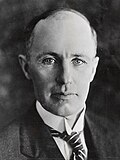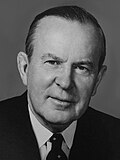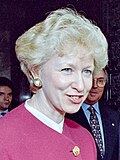Top Qs
Timeline
Chat
Perspective
List of prime ministers of Canada
From Wikipedia, the free encyclopedia
Remove ads
The prime minister of Canada is the official who serves as the primary minister of the Crown, chair of the Cabinet, and thus head of government of Canada. Twenty-four people (twenty-three men and one woman) have served as prime minister. Officially, the prime minister is appointed by the governor general of Canada, but by constitutional convention, the prime minister must have the confidence of the elected House of Commons. Normally, this is the leader of the party caucus with the greatest number of seats in the house. However, in a minority parliament the leader of an opposition party may be asked to form a government if the incumbent government resigns and the governor general is persuaded that they have the confidence of the House.

By constitutional convention, a prime minister holds a seat in parliament and, since the early 20th century, this has more specifically meant the House of Commons.[1]
The 24th and current prime minister is Mark Carney, who assumed office on 14 March 2025. There are currently six living former prime ministers. The most recent former prime minister to die was Brian Mulroney, on 29 February 2024.
Remove ads
Model
The office is not outlined in any of the documents that constitute the written portion of the Constitution of Canada; executive authority is formally vested in the sovereign and exercised on the sovereign's behalf by the governor general. The prime ministership is part of Canada's constitutional convention tradition. The office was modelled after that which existed in the United Kingdom at the time of Confederation. John A. Macdonald was commissioned by the Viscount Monck on 24 May 1867 to form the first government of the Canadian Confederation. On 1 July 1867, the first ministry assumed office.[2]
Remove ads
Term
Summarize
Perspective
When the prime minister begins their term is determined by the date that they are sworn in as prime minister or, if they do not take an oath as prime minister, the date they were sworn into another portfolio, as an oath of office as prime minister is not required.[3] However, since 1957, all incoming prime ministers have sworn an oath as prime minister.[3] Before 1920, prime ministers' resignations were accepted immediately by the governor general and the last day of the ministries were the date he died or the date of resignation.[3] Since 1920, the outgoing prime minister has only formally resigned when the new government is ready to be formed.[3] The Interpretation Act of 1967 states that "where an appointment is made effective or terminates on a specified day, that appointment is considered to be effective or to terminate after the end of the previous day".[3] Thus, although the outgoing prime minister formally resigns only hours before the incoming ministry swears their oaths, both during the day, the ministries are effectively changed at midnight the night before. Some sources, including the Parliament of Canada, apply this convention as far back as 1917.[4] Two prime ministers have died in office: John A. Macdonald (1867–1873, 1878–1891) and John Thompson (1892–1894), both of natural causes. All others have resigned, either after losing an election or upon retirement.
Remove ads
Prime ministers
Summarize
Perspective
Canadian custom is to count by the individuals who were prime minister, not by terms.[5] Since Confederation, 24 prime ministers have been called upon by the governor general to form 30 Canadian ministries.[5]
| Abbreviation key: | No.: Incumbent number, Min.: Ministry, Refs: References |
| Colour key: | Historical Conservative parties (including Liberal-Conservative, Conservative (Historical), Unionist, National Liberal and Conservative, Progressive Conservative) |
| Provinces key: | AB: Alberta, BC: British Columbia, MB: Manitoba, NS: Nova Scotia, ON: Ontario, QC: Quebec, SK: Saskatchewan |
Remove ads
Timeline

Lifespan timeline

See also
- Fathers of Confederation
- Historical rankings of prime ministers of Canada
- Leader of the Official Opposition (Canada)
- List of Canadian federal parliaments
- List of Canadian monarchs
- List of prime ministers of Canada by time in office
- List of prime ministers of Canada by religious affiliation
- List of prime ministers of Queen Victoria
- List of prime ministers of Edward VII
- List of prime ministers of George V
- List of prime ministers of Edward VIII
- List of prime ministers of George VI
- List of prime ministers of Elizabeth II
- List of prime ministers of Charles III
- List of joint premiers of the Province of Canada
- Spouse of the prime minister of Canada
Remove ads
References
Further reading
External links
Wikiwand - on
Seamless Wikipedia browsing. On steroids.
Remove ads





























